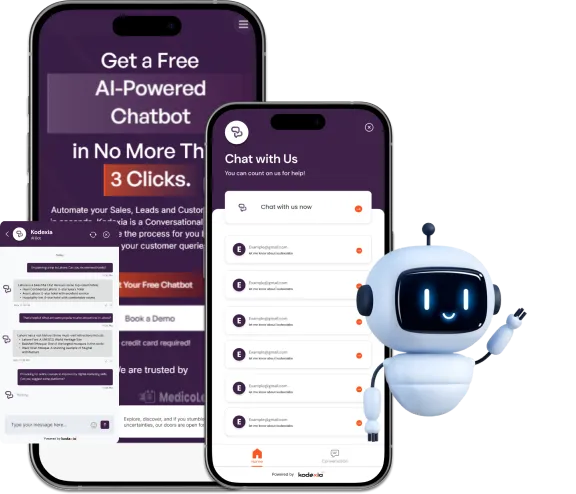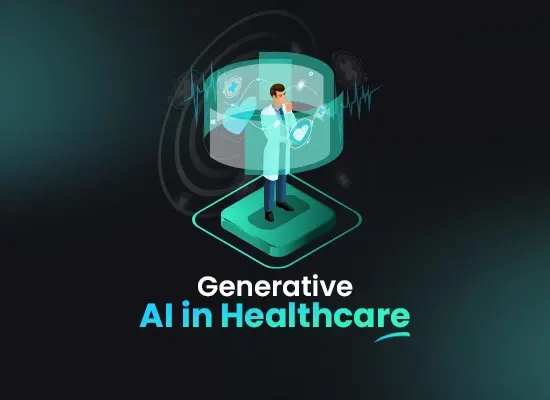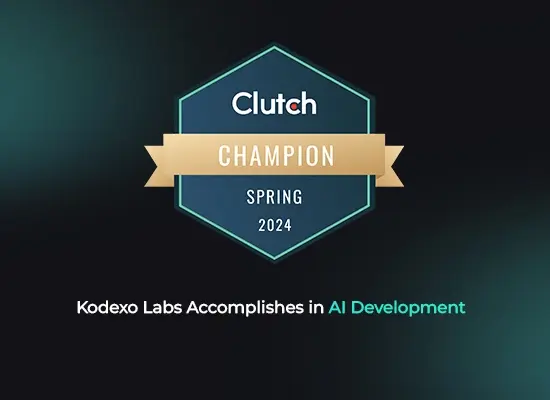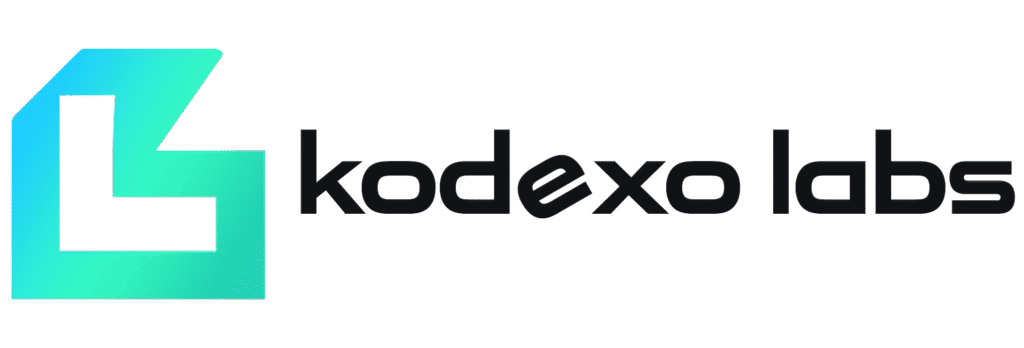Software Development in New York: Benefits, Use Cases, Process & Cost Explained
- Ali Hasan
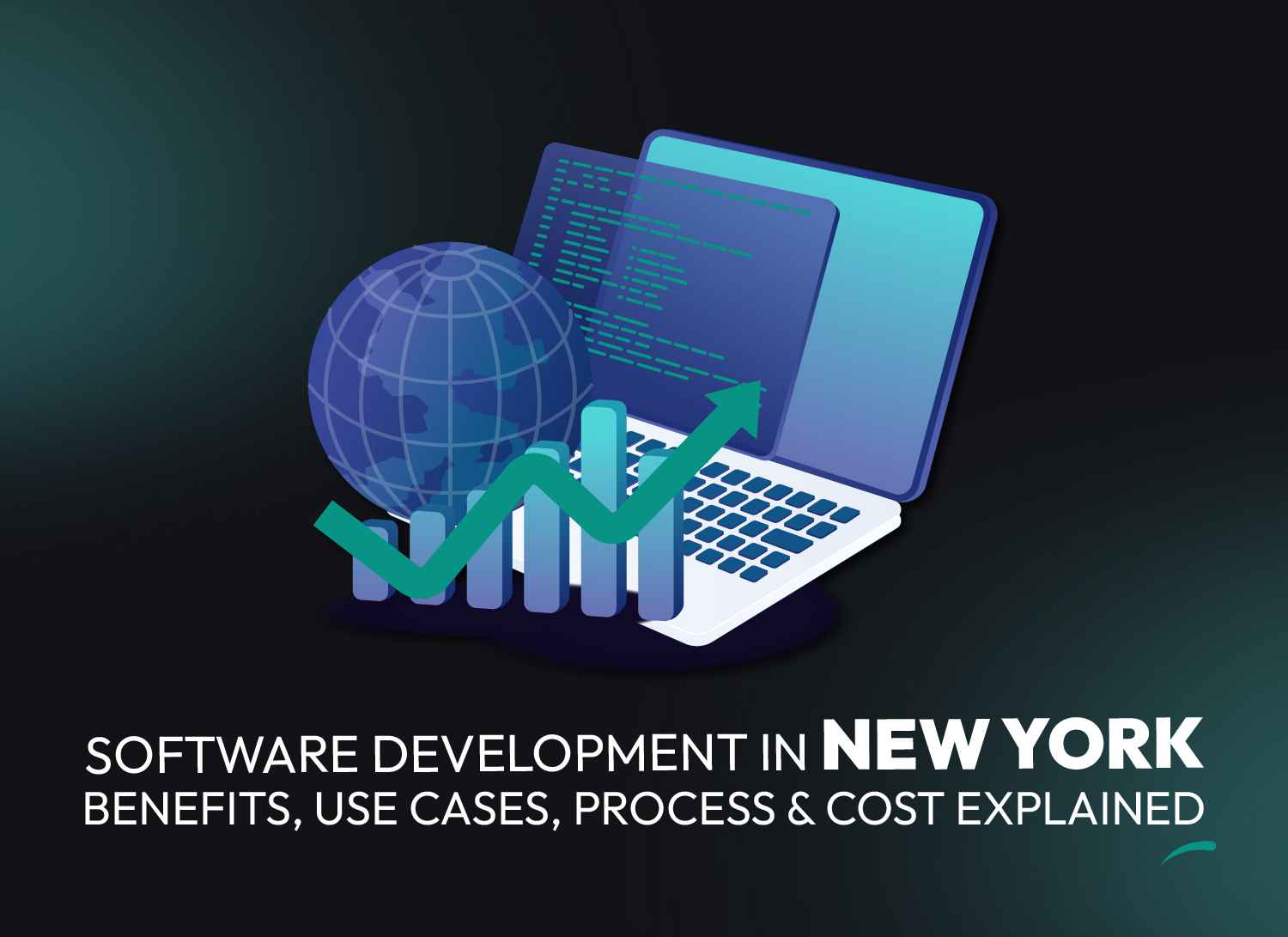
Contents
In the rapidly evolving world of technology, New York City stands tall as a powerhouse of innovation and software development. Its unique blend of world-class talent, robust infrastructure, and proximity to global industries has positioned it as a top destination for custom software solutions.
In 2025, NYC’s software development market is projected to grow by an impressive 12% year-over-year, outpacing the national average by nearly 4%, according to the 2025 Tech Economic Impact Report by NYCEDC. This rapid expansion is fueled by cutting-edge advancements in AI, fintech, and enterprise SaaS platforms tailored to meet the complex needs of the city’s diverse business landscape.
Start Building Software in NYC Without Delays, Doubts, or Hidden Costs
Let's Talk
Why NYC? Key Drivers of Software Innovation:
1. Industry Demand:
Digital health startups and hospital systems require HIPAA-compliant EHR integrations and telemedicine platforms, such as those pioneered by NYC-based innovators like ABC HealthTech.
2. Innovation Districts:
- Silicon Alley remains the epicenter of enterprise SaaS and B2B solutions, housing 40% of NYC’s software development companies.
- Brooklyn Tech Triangle (DUMBO, Downtown Brooklyn, Navy Yard) is a hotspot for agile startups and creative tech collaborations, fostering groundbreaking software projects.
3. Talent & Infrastructure:
- NYC’s Tech Talent Pipeline has expanded by 18% since 2023, with over 25,000 software engineers graduating annually from local bootcamps and universities, fueling the city’s software development workforce.
- Government initiatives like Startup.nyc provide tax incentives for early-stage tech firms, encouraging innovation and growth.
What This Guide Covers:
Market Overview & Current Trends in New York Software Development (2025):
New York City’s software development sector continues to thrive in 2025, fueled by record-breaking venture capital investments, rapid AI adoption, and a surge in fintech innovation. The city remains second only to Silicon Valley in tech funding, with over $28 billion invested in NYC-based startups in the past year alone (CB Insights, 2025).
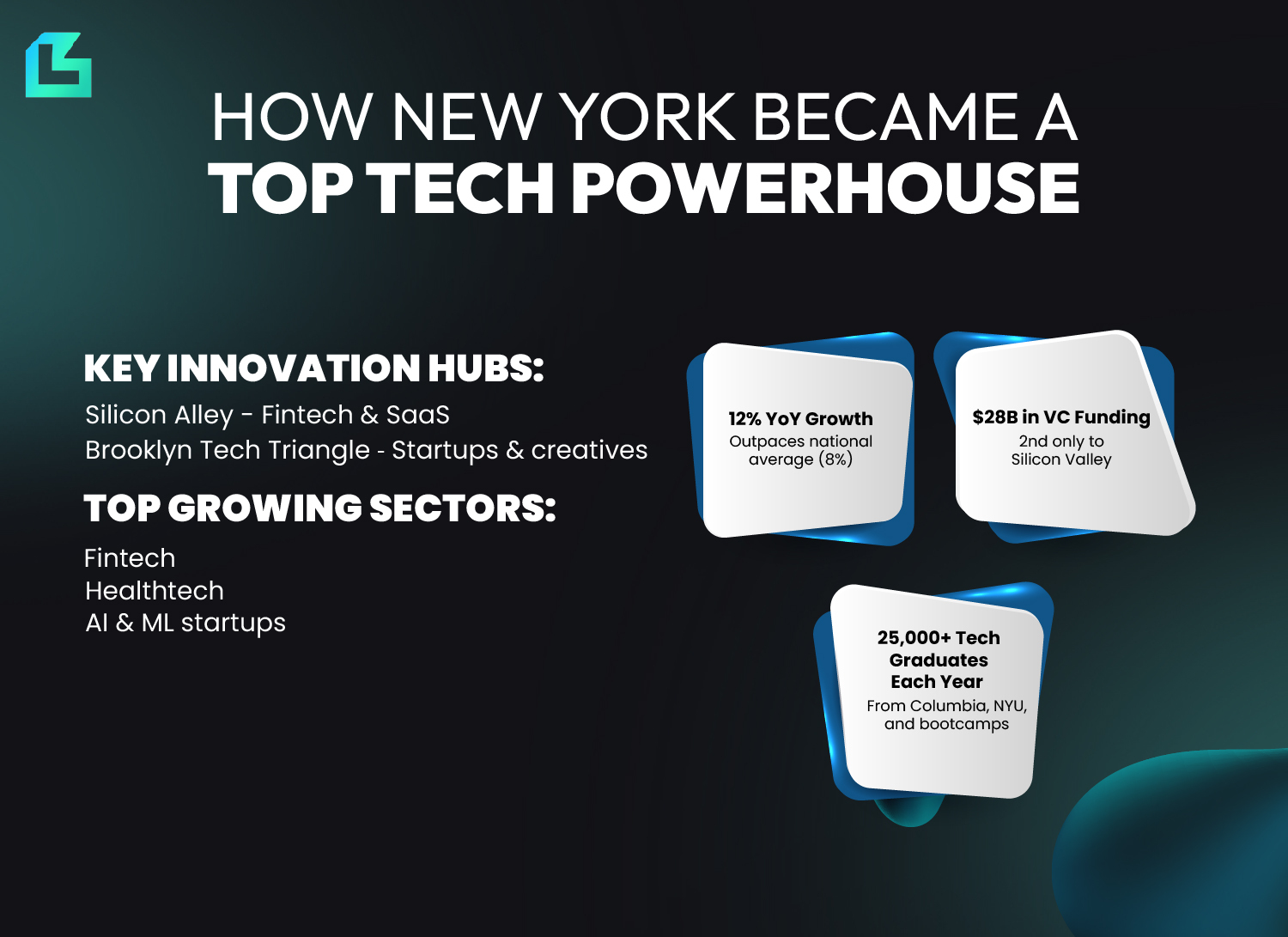
Key Market Dynamics Shaping NYC’s Software Development:
1. Surging Venture Capital & Startup Growth:
2. Government & Institutional Support:
- The NYC Tech Talent Pipeline trains over 10,000 engineers annually in high-demand skills like AI, cybersecurity, and cloud-native development (NYC.gov).
- Startup.nyc tax incentives have benefited 300+ early-stage software firms, accelerating innovation in AI and SaaS sectors.
3. Evolving Development Methodologies:
Future of Software Development in NYC:
- AI-first development strategies, including custom large language models (LLMs) for financial forecasting and automated compliance checks aligned with NY DFS regulations, will dominate.
- Low-code and no-code platforms are accelerating MVP launches in competitive sectors such as media and real estate.
- Stricter cybersecurity mandates from NY DFS and HIPAA regulations will drive demand for secure, audit-ready software solutions.
Why This Matters for Businesses:
Core Technologies Powering NYC’s Software Development in 2025:
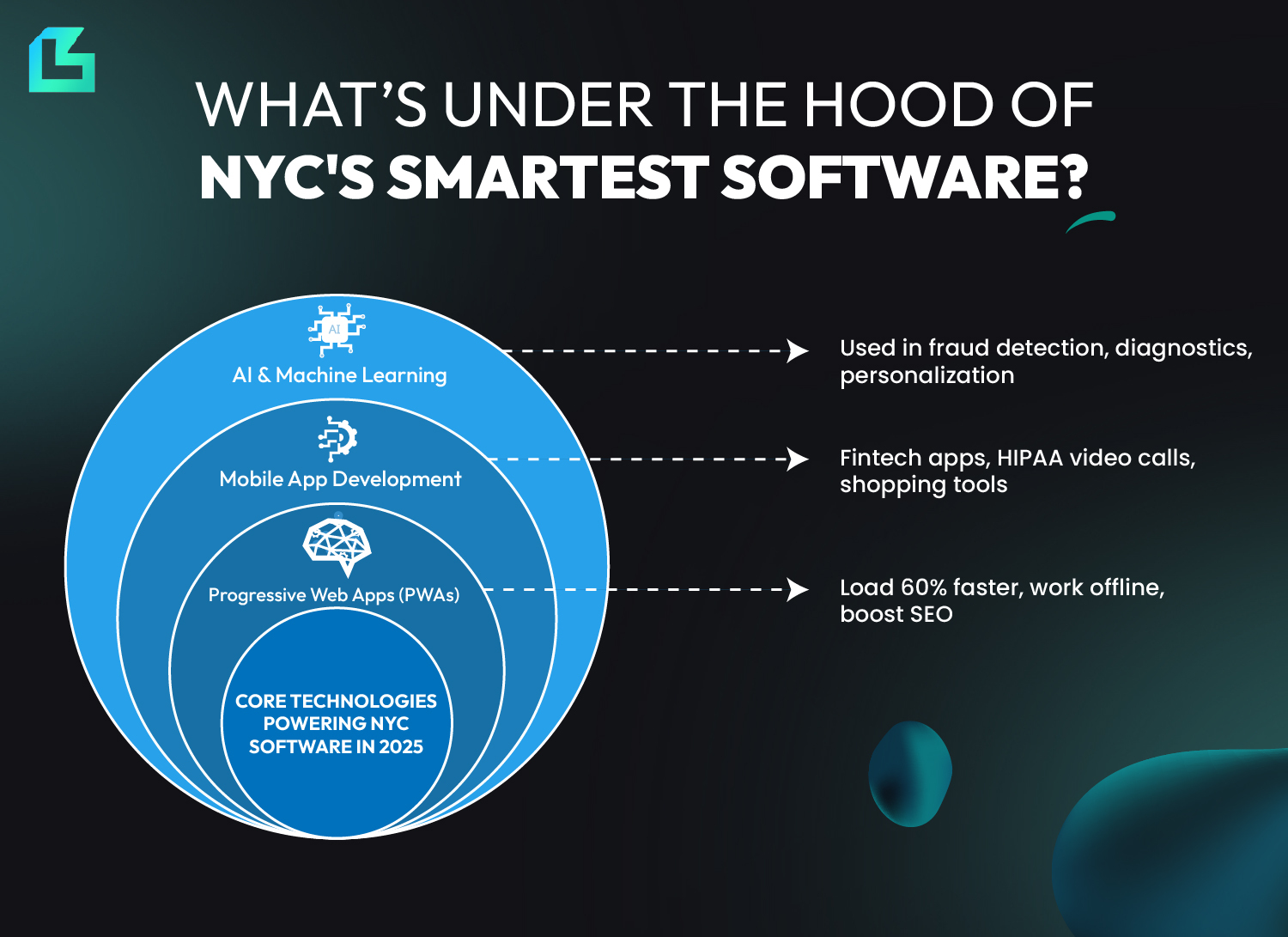
1. AI & Machine Learning: The Brains Behind NYC’s Tech Surge:
2. Mobile App Development: Powering On-the-Go NYC:
With 87% of New Yorkers relying on smartphones daily (NYC.gov Mobility Report 2025), mobile-first development is essential.
Key trends across sectors include:
3. Progressive Web Apps (PWAs): Faster, Leaner, More Engaging:
| Benefits | Description |
|---|---|
| Lower Development Cost | Single codebase for both web and mobile platforms |
| Improved Performance | PWAs load 60% faster than traditional web apps |
| SEO & Discoverability | Enhanced organic search visibility |
Need AI, Mobile or PWA Development? Let’s Build the Right Stack.
Let's Talk
How Agile & SDLC Methodologies Optimize Development:
Agile Software Development in NYC:
Software Development Life Cycle (SDLC) Phases:
Key Takeaways for NYC Businesses:
- AI and Machine Learning are transforming finance, healthcare, and media with predictive analytics and personalization.
- Mobile apps remain essential for engaging NYC’s fast-moving, on-the-go population.
- PWAs offer a cost-effective, high-performance alternative to native apps.
- Agile and SDLC methodologies enable faster, compliant, and user-centric software delivery.
Software Development Services in New York: Custom Solutions for Industry-Specific Needs Across NYC Boroughs
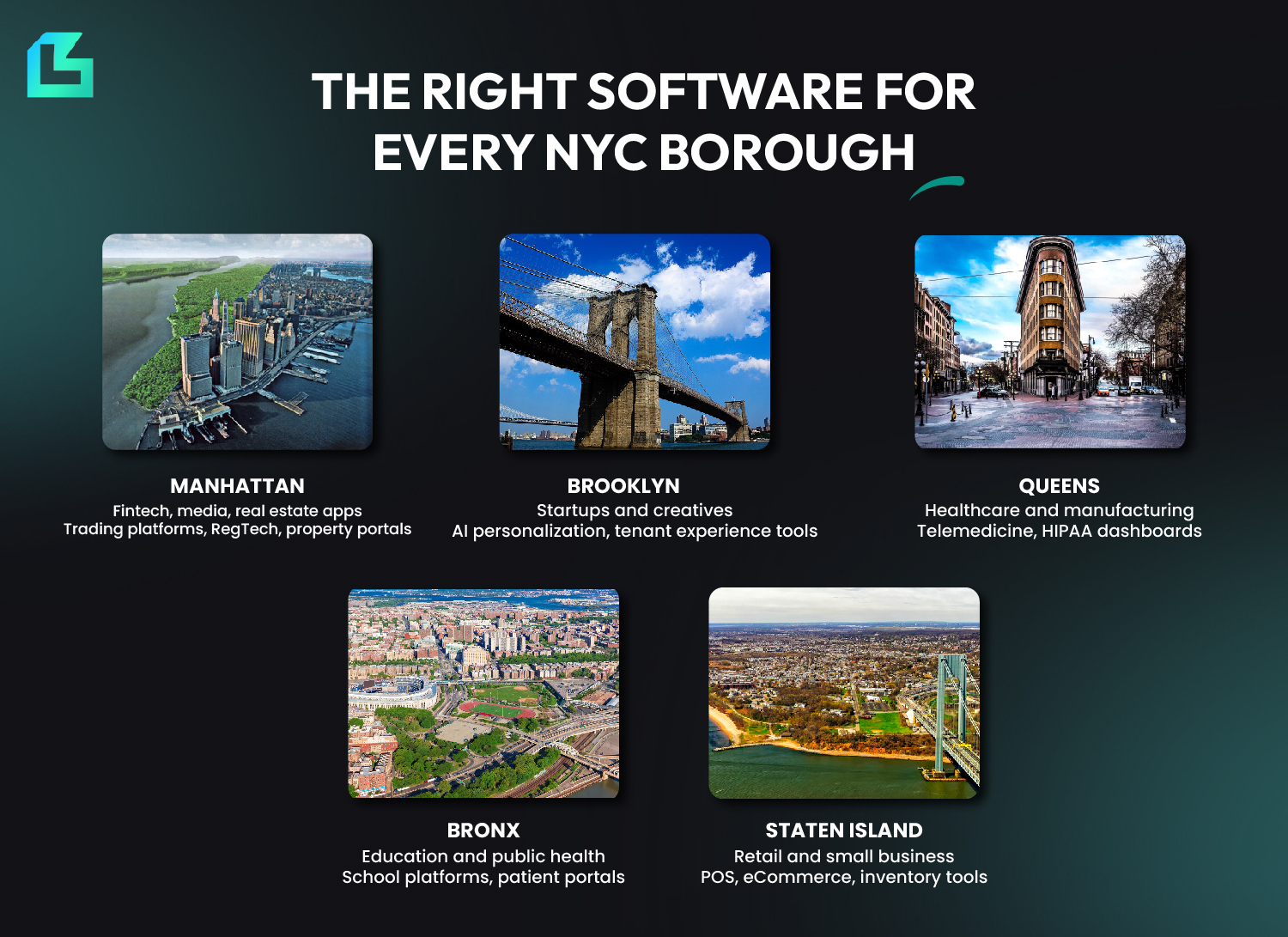
Core Software Development Services Offered Across NYC in 2025:
1. Custom Software Development Tailored to NYC Boroughs:
Why It Matters:
Off-the-shelf software rarely fits the unique compliance and operational needs across NYC’s boroughs, which is why businesses increasingly turn to custom software development in New York to meet borough-specific regulations like NY DFS and HIPAA.
| Borough | Industry Focus | Custom Software Solutions |
|---|---|---|
| Manhattan | Finance, Media, Real Estate | Algorithmic trading, RegTech, media content platforms |
| Brooklyn | Startups, Creative Industries | Custom SaaS, tenant engagement portals, AI personalization |
| Queens | Healthcare, Manufacturing | HIPAA-compliant EHRs, telemedicine, data management systems |
| Bronx | Healthcare, Education | Patient portals, school management systems |
| Staten Island | Small Businesses, Retail | POS systems, inventory management |
Kodexo Labs’ Edge:
2. SaaS Development Across NYC Boroughs:
| Borough | Popular SaaS Use Cases |
|---|---|
| Manhattan | Portfolio management tools for financial firms |
| Brooklyn | Subscription-based creative collaboration platforms |
| Queens | SaaS telemedicine solutions for local clinics |
| Bronx | SaaS education management for schools |
| Staten Island | Retail inventory and POS systems for SMBs |
3. Mobile & Web App Development Designed for NYC’s Mobile Population:
| Borough | Mobile App Trends & Needs |
|---|---|
| Manhattan | Secure fintech apps with biometric authentication |
| Brooklyn | Lifestyle and event apps targeting creatives |
| Queens | Telemedicine portals enhancing patient access |
| Bronx | Community engagement and education apps |
| Staten Island | Retail shopping assistants and local business apps |
4. Enterprise Software Integration Supporting NYC’s Complex Operations:
| Integration Need | Example Boroughs |
|---|---|
| API-First Integration | Manhattan, Queens |
| Middleware Development | Brooklyn, Bronx |
| Secure Data Migration | Staten Island, Manhattan |
5. Software Maintenance & Support — Borough-Specific Considerations:
Key Maintenance Services:
- Proactive 24/7 monitoring tuned to local operational hours and regulations.
- Timely security patches aligned with NY DFS and HIPAA updates applicable to borough industries.
- Agile-driven feature enhancements responding to fast-moving local market demands.
Why Outsource in NYC?
- Cost-effective versus hiring across diverse borough labor markets.
- Access to specialized talent with deep understanding of borough-specific compliance and workflows.
Why Choose a NYC-Based Software Development Company Like Kodexo Labs?
Why Choose New York for Software Development in 2025? Key Benefits & Success Factors:
1. Unrivaled Access to Top Tech Talent:
Why It Matters:
2. Proximity to Industry Leaders — Accelerating Innovation:
Why It Matters:
3. Thriving Innovation Ecosystems — Silicon Alley & Brooklyn Tech Triangle:
Why It Matters:
4. Built-In Regulatory Expertise — Minimize Risk & Cost:
Why It Matters:
5. Agile, Fast-Paced Development Culture — Designed for NYC Speed:
85% of NYC teams combine remote and in-office Agile practices for flexibility (Gartner 2025).
Why It Matters:
6. Strong Investment & Cost Advantages:
Why It Matters:
Use Cases and Industry Applications of Software Development in New York:
Case Study: Teacher AI | AI-Powered Language Learning Platform
Project Overview:
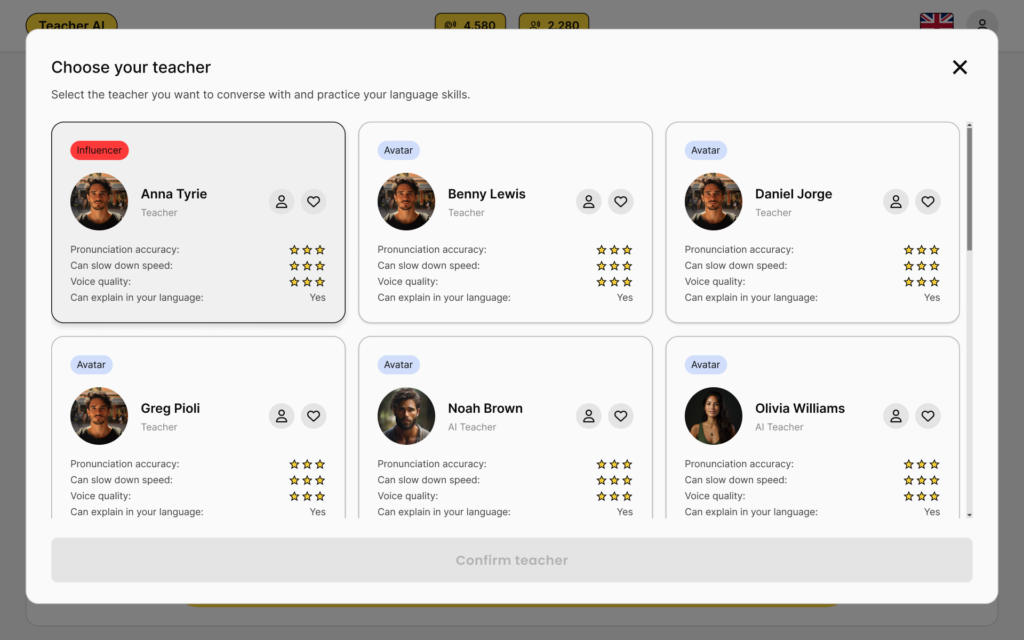
Challenges:
Solutions Implemented:
Technology Stack:
- Next.js
- PostgreSQL (Primary database)
- FastAPI
- Python
Impact Metrics:
95% of users confirm faster learning with instant feedback.
Why This Use Case Matters?
Read More Related Blogs:
Software Development Process in New York: Standard Approaches vs. Kodexo Labs’ NYC-Optimized Method
Why New York Requires a Tailored Software Development Approach:
The software development landscape in New York City is distinctively fast-paced, highly competitive, and subject to stringent regulatory requirements including NY DFS, HIPAA, and local real estate laws. Success in this environment demands more than technical expertise; it requires a development process that prioritizes agility, regulatory compliance, and culturally relevant user experience design tailored to the city’s diverse and mobile-first population (NYC.gov Mobility Report 2025).
While many firms operating in New York rely on conventional Agile or Waterfall methodologies, these approaches often overlook critical local market nuances and regulatory considerations. Kodexo Labs, however, employs a proprietary five-phase process specifically designed to address the unique challenges of New York’s software ecosystem. This approach results in faster, more compliant, and higher-impact software delivery.
Common Limitations of Typical Software Development Processes in New York:
Kodexo Labs’ Proprietary Five-Step Software Development Process Tailored for New York:
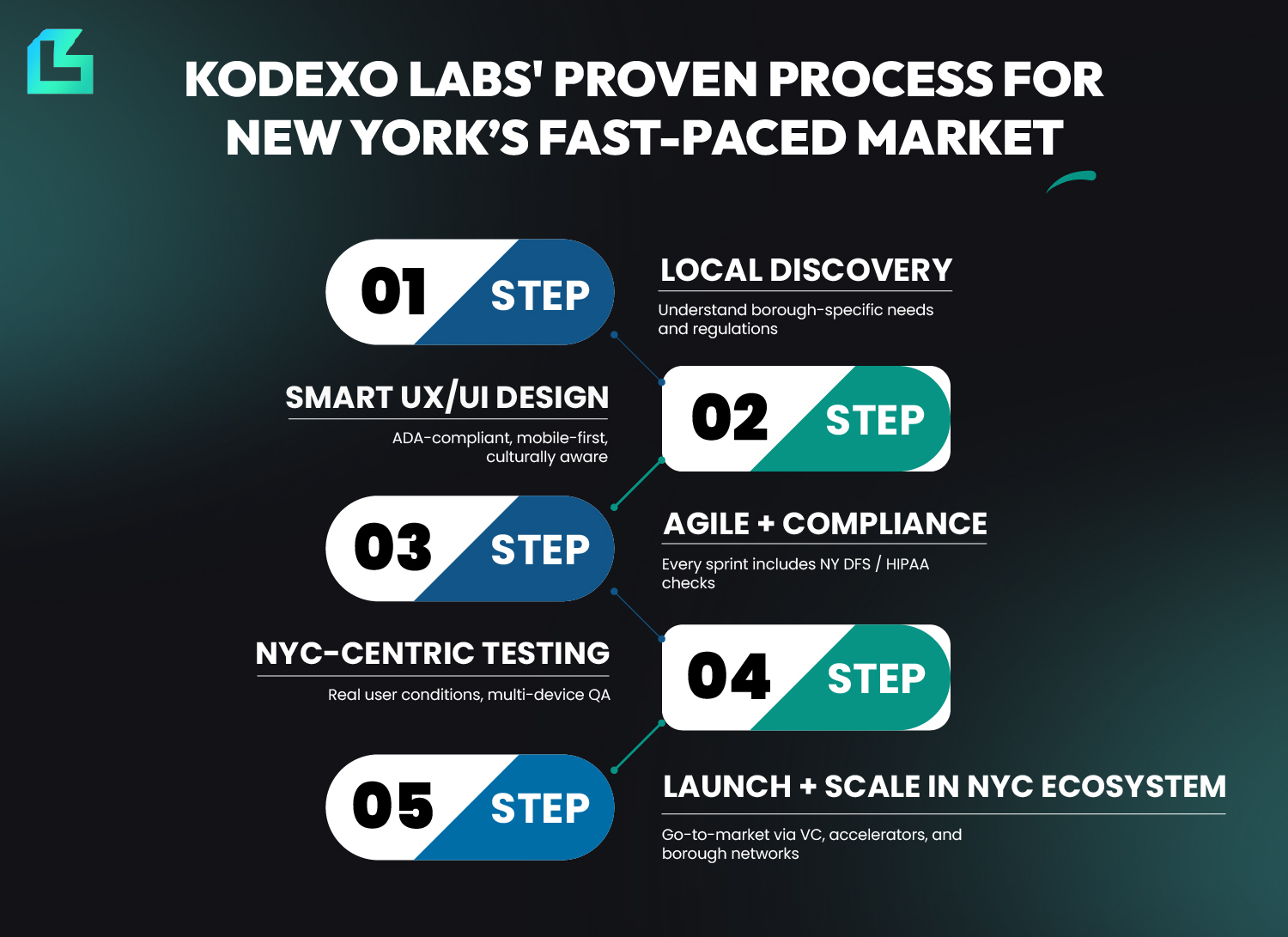
1. Deep-Dive Discovery:
2. Culturally Informed UX/UI Design:
3. Agile Development with Embedded Compliance:
4. New York-Focused Launch and Testing:
5. Strategic Go-to-Market Execution:
Tired of One-Size-Fits-All Development? Let’s Build the NYC Way.
Let's Talk
Comparative Overview: Typical New York Software Development vs. Kodexo Labs’ Approach
| Aspect | Typical NYC Software Development | Kodexo Labs’ NYC-Optimized Process |
|---|---|---|
| Business Discovery | Broad market research with limited local focus | Borough-level stakeholder engagement and detailed regulatory mapping |
| UX/UI Design | Generic, one-size-fits-all | Culturally tailored, ADA-compliant, mobile-optimized design |
| Compliance Integration | Addressed late or reactively | Embedded throughout every sprint and development phase |
| Agile Execution | Inconsistent sprint schedules and feedback loops | Strict two-week sprints with continuous stakeholder engagement |
| Go-to-Market Strategy | Limited use of local venture and accelerator networks | Strategic launch leveraging NYC innovation hubs and investor communities |
Conclusion:
Building software in New York City demands a development process that goes beyond generic methodologies. Kodexo Labs’ proprietary five-step approach ensures software solutions are delivered with greater speed, full regulatory compliance, and a design tailored to New York’s diverse users. This comprehensive, local-first process significantly reduces risks and costs while enhancing user engagement and market success.
For organizations seeking to thrive in New York’s challenging software landscape, Kodexo Labs offers a proven path to scalable, compliant, and user-focused digital innovation.
Cost of Software Development in New York (2025) — Comprehensive Breakdown and Smart Budgeting Strategies:
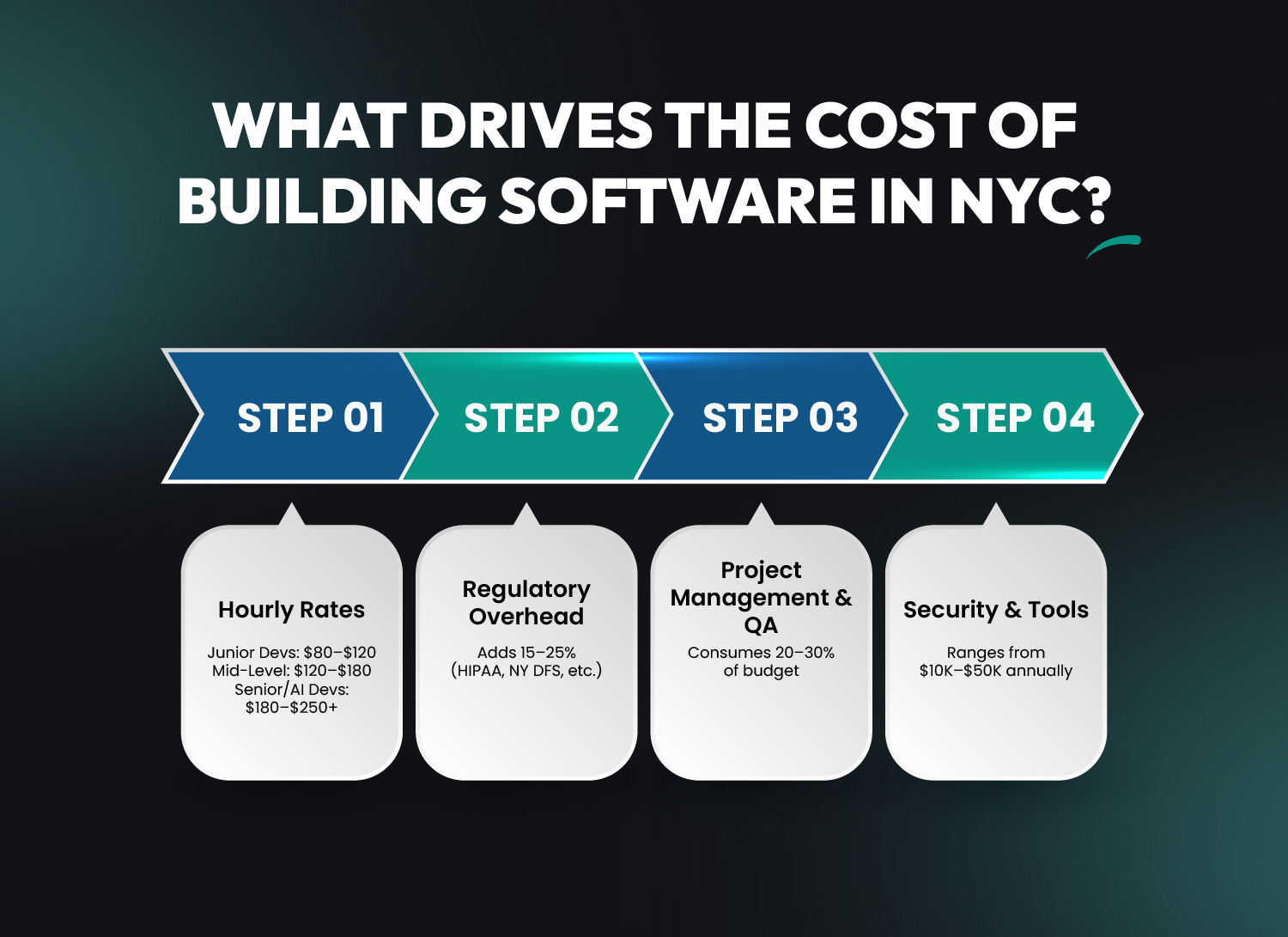
1. NYC Software Development Cost Overview (2025 Rates):
Key Cost Drivers:
- Junior Developers: $80–$120 per hour
- Mid-Level Developers: $120–$180 per hour
- Senior Engineers (AI, Cybersecurity): $180–$250+ per hour
Why Does Software Development Cost More in NYC?
- High demand for specialized skills in AI, fintech, and cybersecurity.
- Strict regulatory requirements, including NY DFS cybersecurity rules and HIPAA compliance.
- The cost of living in NYC is approximately 35% above the U.S. average (NYC.gov Mobility Report 2025), driving higher salary expectations.
2. NYC vs. Other U.S. Tech Hubs: Cost Comparison
| City | Average Hourly Rate | Key Cost Factors | Best For |
|---|---|---|---|
| New York | $120–$250 | Compliance-heavy projects (fintech, healthtech) | Enterprises, regulated industries |
| Silicon Valley | $150–$300 | AI/ML, scaling unicorns | VC-backed startups |
| Austin | $90–$180 | Lower taxes, growing talent pool | Mid-market SaaS |
| Boston | $100–$200 | Healthtech/biotech focus | Research-driven software |
Takeaway:
3. Hidden Costs: Compliance & Regulatory Overhead
NY DFS Cybersecurity Requirements (Fintech/Insurtech):
- Mandatory audits, encryption, and penetration testing add $25,000–$100,000+ upfront.
- Ongoing compliance monitoring ranges from $15,000 to $50,000 annually.
HIPAA Compliance (Healthcare Applications):
- Costs for secure data storage, access controls, and audit trails typically range from $30,000 to $80,000 upfront.
NYC-Specific Laws (Real Estate, Data Privacy):
- Tenant data protection and ADA compliance can add $10,000–$40,000 to project budgets.
Failing to budget for these costs risks significant fines (up to $250,000 for NY DFS violations) and reputational damage.
4. How Project Complexity Impacts Budget:
| Project Type | Average Cost Range | Key Cost Drivers |
|---|---|---|
| MVP (Fintech App) | $80,000–$150,000 | NY DFS compliance, API integrations |
| Enterprise SaaS | $200,000–$500,000+ | Scalability, HIPAA/NY DFS, multi-tenant setup |
| Healthcare Portal | $150,000–$300,000 | HIPAA audits, patient data security |
Additional Complexity Factors:
- Integrations with banking APIs, EHR systems: +$20,000–$80,000
- High-security requirements like biometric login or encryption: +$30,000–$100,000
5. Cost-Saving Strategies for NYC Businesses:
1. Hybrid Teams (Onshore + Nearshore):
NYC-based project managers combined with Latin American developers through software development outsourcing can reduTalent Competitionce costs by 30–40%.
2. Agile MVP Development:
3. Compliance-First Partnerships:
4. Fixed-Price Contracts for Well-Defined Projects:
5. Leverage NYC Tax Incentives:
NYC Software Doesn’t Have to Break the Bank—We’ll Show You How
Let's Talk
Challenges Unique to New York Software Development:
1. Talent Competition: Hiring and Retaining Top Tech Skills
The Challenge:
New York City hosts a dense concentration of Fortune 500 companies, startups, and fintech giants, creating a significant imbalance between job openings and qualified candidates. The NYC Tech Talent Pipeline reports a 3:1 ratio of tech job openings to qualified candidates in 2025. Salaries for specialized roles reflect this demand:
- AI and Machine Learning Engineers: $220,000–$300,000 base salary (up 25% since 2023)
- Cybersecurity Experts: $180,000–$260,000 (Crunchbase Salary Report)
Moreover, approximately 40% of hires leave within 18 months for competing offers, increasing recruitment costs and project disruption.
Solutions:
- Leverage NYC’s $10,000 per year tax credits for employee upskilling programs.
- Offer equity-heavy compensation packages to attract talent in competition with larger firms.
- Employ nearshore augmentation by combining NYC leadership with skilled developers from Latin America or Europe.
2. Soaring Operational and Labor Costs:
The Challenge:
Operational expenses in New York significantly impact development budgets:
- Salaries are approximately 35% higher than in cities like Austin or Chicago (NYC.gov Mobility Report 2025).
- Office rents in Midtown Manhattan exceed $95 per square foot, compared to $38 nationally.
- Compliance overhead adds 20–30% to project costs.
Solutions:
- Use hybrid office models and flexible workspaces to reduce real estate expenses by up to 50%.
- Utilize tax incentives such as the 10-year exemptions offered by Startup.nyc for qualifying tech firms.
- Adopt fixed-scope MVP development to validate ideas before committing to larger investments.
3. Navigating NYC’s Complex Regulatory Environment:
The Challenge:
| Regulation | Impact | Cost if Ignored |
|---|---|---|
| NY DFS Cybersecurity | Requires encryption, audits, CISO oversight | Fines exceeding $250,000 |
| HIPAA | Enforces strict patient data controls | Penalties over $1 million per breach |
| Local Law 144 | Mandates AI bias audits | 15% increase in project costs |
Solutions:
- Integrate “compliance by design” principles, embedding regulatory requirements into system architecture from project inception.
- Use pre-vetted templates and reusable frameworks for NY DFS and HIPAA compliance.
- Employ dedicated regulatory liaisons to streamline audit processes.
NYC projects fail when teams treat compliance as Phase 2. It must be Phase 0.
TechCrunch Regulatory Roundtable (2025)
4. Managing Diverse and Hybrid Teams
The Challenge:
Nearly 47% of NYC tech workers are foreign-born (Brookings Institution) and teams often span five or more time zones. Managing such diversity and hybrid work models poses challenges:
- 35% of NYC firms report productivity drops linked to hybrid team friction (Forbes).
- Communication barriers and cultural misunderstandings can delay projects.
Solutions:
- Adopt asynchronous communication tools like Loom and Notion, combined with scheduled synchronous windows.
- Implement cultural onboarding and diversity training to reduce miscommunication by up to 40%.
- Organize quarterly in-person sprints to address complex problem-solving and strengthen team cohesion
5. Cybersecurity Threats and Skill Obsolescence:
The Challenge:
Solutions:
- Offer continuous upskilling programs with bi-annual certifications.
- Implement zero-trust security architectures as standard practice for fintech and healthtech projects.
- Conduct threat-mimicking QA through red-team testing prior to launch.
Turning Challenges into Advantages:
Challenges Unique to New York Software Development:
New York City’s status as a global hub for finance, healthcare, and real estate comes with stringent regulatory demands. Software developed for these industries must comply with NY DFS cybersecurity rules, HIPAA, and other local laws—or risk severe penalties. This guide breaks down these critical regulations, their impact on development, and how to embed compliance seamlessly into your software development Life Cycle (SDLC).
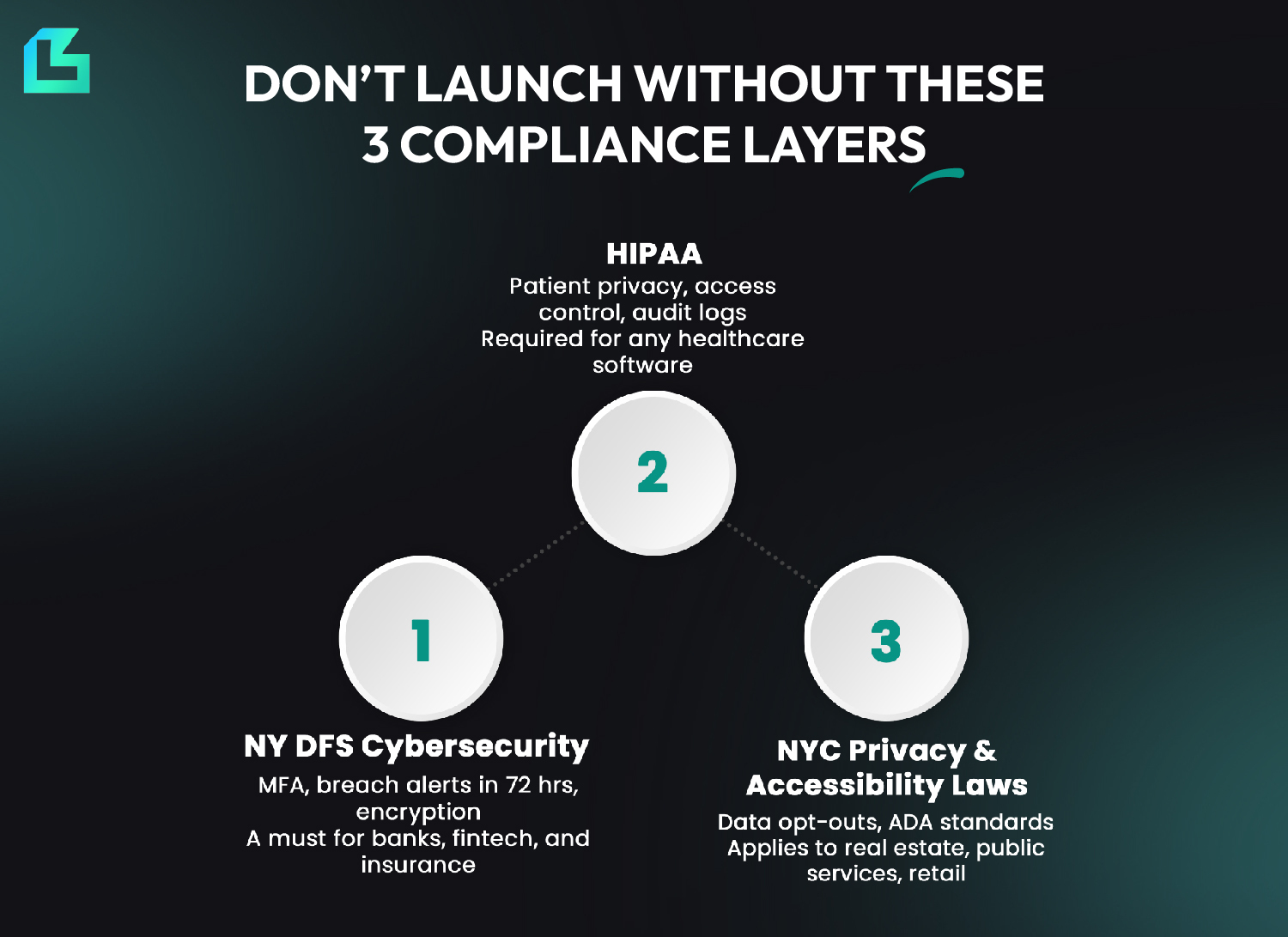
1. NYC’s Regulatory Environment: Why Compliance Can’t Be an Afterthought
| Regulation | Applies To | Key Requirements | Penalties for Non-Compliance |
|---|---|---|---|
| NY DFS Cybersecurity | Banks, insurers, fintech firms | Encryption, multi-factor authentication, incident reporting | Up to $250,000 per violation |
| HIPAA | Healthcare apps, EHR systems | Patient data protection, audit trails | $1 million+ per breach |
| NYC Data Privacy Laws | Consumer-facing applications | Transparency, opt-out options | $10,000–$50,000 fines |
Why It Matters:
- NY DFS: 43% of fintech startups face delays due to late-stage compliance fixes (NY DFS Annual Report (2023)).
- HIPAA: Healthcare data breaches cost an average of $9.3 million (HHS, 2025).
2. NY DFS Cybersecurity Regulation: A Developer’s Guide
Who Must Comply?
Core Requirements:
- Data Encryption: AES-256 encryption for data at rest and in transit. Building regulation-ready platforms for NYC-based fintech firms involves integrating encryption, MFA, and breach reporting per NY DFS cybersecurity standards right from the design phase.
- Multi-Factor Authentication (MFA): Mandatory for all customer-facing applications.
- Annual Penetration Testing: Third-party security audits are required.
- 72-Hour Breach Reporting: Must notify NY DFS and affected users within 72 hours of a breach.
- CISO Oversight: Cybersecurity accountability at the board level through a designated Chief Information Security Officer.
Integrating NY DFS into SDLC:
- Design Phase: Map data flows to identify where encryption must be applied.
- Development: Use pre-approved security libraries such as OpenSSL or AWS Key Management Service.
- Testing: Automate vulnerability scanning with tools like OWASP ZAP.
3. HIPAA Compliance for Healthcare Software:
Key Rules and Developer Responsibilities:
| HIPAA Rule | Developer Action Items |
|---|---|
| Privacy Rule | Implement patient consent workflows, data anonymization |
| Security Rule | Enforce role-based access controls and maintain audit logs |
| Breach Notification | Comply with a 60-day reporting window for data leaks |
Technical Challenges:
- Secure APIs for EHR integrations must use TLS 1.3+ and OAuth 2.0 authentication protocols.
- Maintain detailed audit trails logging who accessed Protected Health Information (PHI), when, and why.
- Apply data minimization principles to store only essential patient data.
Recommended Tools:
4. Building Compliance into Your SDLC:
| SDLC Stage | NY DFS Actions | HIPAA Actions |
|---|---|---|
| Planning | Identify regulated data flows | Conduct comprehensive risk analysis |
| Design | Encrypt data schemas | Pseudonymize PHI data fields |
| Development | Embed MFA SDKs | Implement detailed audit logging |
| Testing | Perform penetration tests per NY DFS checklist | Validate breach response times |
| Maintenance | Conduct quarterly security training | Monitor access logs continuously |
5. Why Partner with a Compliance-Savvy Firm Like Kodexo Labs?
Navigating New York City’s regulatory maze requires proactive integration of compliance into every stage of software development rather than reactive fixes.
Kodexo Labs offers:
- Pre-Mapped Frameworks: Reusable code modules designed for NY DFS and HIPAA compliance.
- In-House Legal Reviews: Expertise to avoid misinterpretations of evolving regulations.
- Continuous Monitoring: Real-time alerts for any compliance drift or security issues.
Cost Implications:
- Retrofitting compliance after development can increase project costs by 50–150%.
- Integrating compliance upfront typically adds only 10–20% to the budget, reducing risk and delays.
Avoid $250K+ Compliance Mistakes. Let Our Experts Handle It.
Let's Talk
Security Best Practices in NYC Software Development: Protecting Fintech and Healthcare Solutions
1. Secure Coding: Building a Foundation of Trust
Tools for Secure Development:
- Static Code Analysis: SonarQube, Checkmarx
- Dynamic Application Security Testing: Burp Suite, OWASP ZAP
- Dependency Scanning: Snyk, WhiteSource
2. Incident Response: Preparing for the Inevitable
NYC Regulatory Requirements:
| Regulation | Response Timeline | Key Actions |
|---|---|---|
| NY DFS | 72-hour breach reporting | Notify regulators and affected customers promptly |
| HIPAA | 60-day breach notification window | Submit breach report to HHS and notify media if over 500 individuals affected |
Proactive Monitoring Strategies:
- Deploy Security Information and Event Management (SIEM) tools such as Splunk or IBM QRadar for real-time intrusion detection.
- Configure automated alerts with platforms like PagerDuty or Slack to notify security teams of anomalous activity.
- Centralize log management using immutable storage solutions such as AWS CloudTrail or Azure Sentinel to ensure audit readiness.
3. Regulatory Adherence and Continuous Auditing:
4. Sector-Specific Security Layers:
Fintech Must-Haves:
- Real-time transaction monitoring and fraud detection using advanced rules engines (e.g., FICO Falcon).
- Secure APIs implementing OAuth 2.0 with NY DFS-compliant rate limiting.
- Use of Hardware Security Modules (HSMs) for secure cryptographic key management.
Healthcare Non-Negotiables:
- Data anonymization in test and development environments using synthetic data generation tools such as Mostly AI.
- EHR integrations following FHIR API standards, with comprehensive audit trails logging all data accesses.
- Patient privacy workflows supporting “right to be forgotten” requirements per HIPAA.
5. Kodexo Labs’ Security-First Approach:
Talent Pipeline and Workforce Development in NYC: Building the Next Generation of Software Professionals
1. NYC’s Tech Talent Ecosystem: Universities and Bootcamps
Top-Tier Universities Fueling Innovation:
- Columbia University: Ranked #1 in NYC for AI and cybersecurity research, graduating over 1,200 computer science majors annually.
- NYU Tandon School of Engineering: Specializes in fintech and data science, with 40% of graduates joining NYC startups.
- Cornell Tech (Roosevelt Island): Focuses on applied technology ventures, spinning out more than 50 startups each year.
Leading Coding Bootcamps (Fast-Tracking Careers):
| Bootcamp | Focus Area | Placement Rate | Average Starting Salary |
|---|---|---|---|
| Flatiron School | Full-stack development, Data Science | 92% | $105,000 |
| Fullstack Academy | Cybersecurity, DevOps | 89% | $98,000 |
| General Assembly | UX/UI, Product Management | 85% | $95,000 |
Bootcamp graduates fill approximately 35% of mid-level developer roles in NYC, helping businesses accelerate their hiring cycles (CB Insights, 2025).
2. NYC Tech Talent Pipeline: Bridging Skill Gaps
The NYC Tech Talent Pipeline initiative plays a vital role in training over 10,000 New Yorkers annually in high-demand areas such as AI, cybersecurity, and Agile development (NYC.gov). Notably:
- 45% of participants come from underrepresented groups including women and Black/Latinx communities.
- The program boasts an 87% job placement rate within six months of completion.
Example: A graduate from the program successfully transitioned from retail to a Python developer role, earning $110,000 annually at a Wall Street fintech firm—demonstrating the initiative’s positive impact on economic mobility.
3. Continuous Learning: Keeping NYC’s Workforce Competitive
The fast-paced evolution of technology demands ongoing upskilling:
- AI and machine learning roles in NYC have grown by 200% since 2023 (LinkedIn, 2025).
- 60% of developers report skill gaps in cybersecurity and cloud-native technologies (HRCSuite – Skills and Technical Proficiency).
Employer Incentives for Training:
- NYC offers tax credits of up to $10,000 per year per employee for approved upskilling programs.
- Corporate-academic partnerships provide valuable opportunities for continuous education, including:
- Google and CUNY offering free AI certifications to 5,000 NYC workers.
- JPMorgan Chase and Flatiron School providing full scholarships to underrepresented developers.
4. Opportunities for Job Seekers and Employers:
Software Developer Job Growth in NYC (2025):
- Projected growth of 14%, compared to 8% nationally.
- Highest-demand roles include:
- AI/ML Engineers: $180,000–$300,000 salary range
- Cybersecurity Specialists: $150,000–$250,000 salary range
- Full-Stack Developers: $120,000–$200,000 salary range
How Employers Can Tap into NYC’s Talent Pool:
- Partner with coding bootcamps to recruit diverse, job-ready candidates.
- Utilize the NYC Tech Talent Pipeline for access to pre-vetted local talent.
- Offer hybrid or flexible roles to attract skilled professionals who might be priced out of Manhattan’s living costs.
Supporting NYC’s Talent Ecosystem:
Leading Software Development Companies and Testimonials in New York:
Kodexo Labs: A Trusted Software Development Partner for Regulated Industries
Why Kodexo Labs is the Preferred Choice:
- Agile development processes tailored for the fast-paced New York market.
- Access to elite local talent from top NYC universities and coding bootcamps.
- In-depth knowledge of industry-specific regulatory requirements to minimize risk.
Real Clients Feedbacks:



Other Leading Software Development Firms in New York:
Eleks:
Intellectsoft:
Ciklum:
Why New York Firms Lead the Industry:
How to Choose the Right Software Development Partner in New York:
1. Define Your Project Needs Clearly:
Pro Tip:
2. Evaluate Technical and Compliance Expertise:
Red Flag:
3. Assess Communication and Collaboration:
Key indicators of a strong partnership:
- Responsiveness through daily standups or weekly demos.
- Use of transparent project management tools like Jira, Trello, or Asana.
- Cultural fit and pace aligned with NYC’s fast-moving environment.
4. Prioritize Local NYC Presence:
Choosing a partner with a local presence offers:
- Faster issue resolution via onsite meetings within hours, not days.
- Deeper regulatory insights from firsthand NY DFS audit experience.
- Access to New York’s elite talent pools from universities such as NYU and Columbia.
Remote Teams:
If offshore resources are considered, ensure overlapping working hours (e.g., Latin America vs. Asia) to minimize communication delays.
5. Demand Pricing Transparency:
| Model | Best For | Potential Risk |
|---|---|---|
| Fixed-Price | Well-defined projects | Scope creep leading to cost overruns |
| Time & Materials | Agile, evolving needs | Budget uncertainty |
| Hybrid | MVP plus scaling phases | Balances flexibility and cost |
6. Verify Track Record and References:
Kodexo Labs Insight:
The Future of Software Development in New York: 2025 Trends and Beyond
1. AI and Generative AI: The New Competitive Edge
By 2026, an estimated 85% of NYC enterprises will integrate generative AI into business workflows (Gartner, 2025). New York’s enterprise ecosystem is embracing Generative AI development to enhance productivity, personalization, and compliance through ethical, bias-audited systems.
- Fintech: AI-driven fraud detection systems operate 60% faster than traditional methods.
- Healthcare: Large language models (LLMs) automate medical coding, reducing administrative costs by 30%.
- Media: AI-powered content personalization increases user engagement by 40%.
2. Fintech Innovation Beyond Blockchain:
- AI-Powered RegTech automates NY DFS compliance, saving firms more than $250,000 annually on audits.
- Real-time fraud prevention leverages machine learning trained on Wall Street transaction data.
- API-first banking solutions integrate securely with 90% of major U.S. banks.
3. Sustainable Software: Coding for a Greener NYC
- AI-driven energy management in smart buildings covers 50% of NYC’s commercial real estate by 2026.
- ESG analytics software helps Fortune 500 companies track Scope 3 emissions.
- Low-carbon coding practices reduce data center power consumption by 20%.
4. Public-Private Partnerships Fueling Growth:
- Startup.nyc provides 10-year tax exemptions for AI, fintech, and climate tech firms.
- NYCEDC’s “AI NYC” fund dedicates $100 million toward responsible AI development.
- Cornell Tech’s Climate Tech Hub incubates over 60 sustainability startups annually.
5. Outlook: Why NYC Will Lead Software Innovation
- Regulatory foresight through NY DFS and HIPAA frameworks attracts compliant innovation.
- Diverse industry demand from finance, healthcare, and media sectors drives real-world AI adoption.
- Concentrated talent pool: 40% of U.S. AI PhDs work in NYC (Brookings, 2025).
- Climate urgency positions NYC as a leading testbed for green software solutions.
Read More Related Blogs:
Conclusion:
New York City stands as a global beacon for high-impact software development, offering unparalleled advantages alongside unique challenges. The city’s dense talent pool, anchored by world-class universities and coding bootcamps, drives innovation across fintech, healthcare, media, and proptech. Forward-thinking yet stringent regulations—such as NY DFS cybersecurity rules and HIPAA—ensure that software solutions are not only cutting-edge but also secure and scalable. Initiatives like Startup.nyc and NYCEDC grants further provide the infrastructure and incentives to transform bold ideas into reality.
However, success in NYC requires more than technical expertise alone. The city’s high operational costs, complex compliance landscape, and fierce talent competition demand partners who combine Agile innovation with regulatory precision. Companies that thrive here leverage local knowledge, hybrid talent models, and compliance-by-design principles to maintain a competitive edge.
For businesses ready to compete in one of the world’s most dynamic tech hubs, the path is clear: collaborate with NYC-savvy developers, embed compliance early in the development process, and iterate rapidly. The rewards—access to elite talent, Fortune 500 clients, and a vibrant culture of relentless innovation—are unmatched.
Hire the Right NYC Software Team Without Guesswork
Let's Talk
Frequently Asked Questions (FAQs)
1. How much does software development cost in New York?
- MVP Development: Typically ranges from $80,000 to $150,000.
- Enterprise Solutions: Can range from $200,000 up to $500,000 or more.
- Compliance Overhead: Meeting NY DFS and HIPAA requirements usually adds 15–25% to the project budget.
- Cost Drivers: Include team seniority, project complexity, and regulatory compliance needs.
2. What is the average timeline for a software project in NYC?
- MVP: Generally 3 to 6 months using Agile sprints.
- Full-Scale Product: Often requires 6 to 12 months.
- Regulatory Approvals: Such as NY DFS audits can add 1 to 3 months.
3. Which industries have the strictest compliance requirements?
- Fintech: Subject to NY DFS cybersecurity rules, including encryption, multi-factor authentication (MFA), and 72-hour breach reporting.
- Healthcare: Must comply with HIPAA, ensuring patient data protection and audit trails.
- Real Estate: Governed by NYC Local Law 97, focusing on energy efficiency tracking.
4. How do I choose the best software development company in NYC?
Look for partners with:
- Industry-specific experience in fintech, healthcare, or your sector.
- Proven compliance expertise with audit-ready case studies.
- Transparent pricing models, whether fixed-cost or hybrid Agile.
- A local NYC presence for quicker iteration and easier regulatory navigation.
5. Can I outsource software development while keeping costs low?
6. What are the trending software development areas in NYC for 2025?
- AI and machine learning, including generative AI applications in finance and healthcare.
- Green software development focused on energy efficiency and ESG compliance.
- RegTech solutions automating NY DFS and HIPAA adherence.
7. How does NYC’s software development talent pool compare to other tech hubs?
- NYC boasts deep fintech and healthtech expertise and produces over 10,000 skilled tech graduates annually from top universities and bootcamps.
- However, salaries tend to be 20–30% higher than the national average.
8. What is the biggest mistake NYC startups make with software development?

